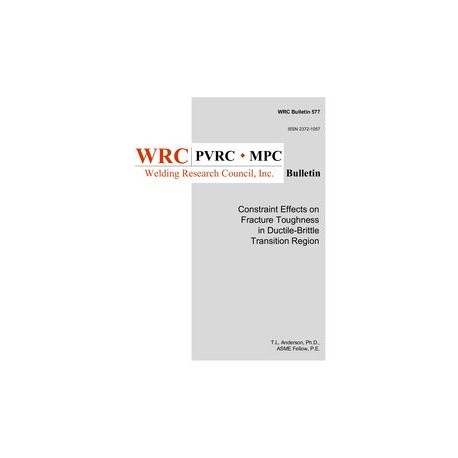Cart
0
Product
Products
(empty)
No products
To be determined
Shipping
$0.00
Total
Product successfully added to your shopping cart
Quantity
Total
There are 0 items in your cart.
There is 1 item in your cart.
Total products
Total shipping
To be determined
Total
 View larger
View larger
WRC 577
M00002255
New product
WRC 577 Constraint Effects on Fracture Toughness in the Ductile-Brittle Transition Region
Bulletin / Circular by Welding Research Council, 2020
T.L. Anderson, Ph.D., ASME Fellow, P.E.
In stock
More info
Full Description
This bulletin reviews the state of the art in constraint effects on fracture in the transition region, and it debunks certain myths that arose during the 1970s about the supposed direct connection between fracture toughness and section thickness. Our current understanding of constraint effects on toughness stems from research that was conducted in the 1990s and early 2000s, when 3D nonlinear finite element analysis became feasible. This bulletin also presents original work whose purpose was to establish the technical basis to incorporate a simple constraint correction into ASME and API Codes and Standards.Constraint theories can be divided into two types: continuum approaches and micromechanics models. The former consist of crack tip similitude parameters that seek to correlate experimental data, while the latter connect crack tip stresses and strains to a local failure criterion. The leading continuum approaches are theory and theory. Evaluating the parameter requires nonlinear finite element analysis with a highly refined mesh at the crack tip, while the T-stress can be computed with an elastic model with normal crack tip refinement. The Weibull stress is the leading model for weakest link cleavage fracture. As with the parameter, the Weibull stress requires nonlinear analysis with high crack tip mesh refinement.
Wallin has developed a simple empirical constraint adjustment based on elastic T-stress, which correlates to the shift in the Master Curve index temperature. This empirical correlation was developed with standard laboratory specimens, so further work was necessary to extend it to structural components. Toward this end, the present report contains the following original research results:The development of a library of T-stress solutions for surface cracks in flat plates and cylindrical shells.A nonlinear finite element study aimed at benchmarking and validating the Wallin correlation for structural components. This study considered a number of complexities in structural applications, including: 3D effects in semi-elliptical surface cracks. The effect of biaxial loadingThe effect of residual stress. This bulletin concludes with a recommended procedure for implementing the Wallin correlation in Fitness-For-Service assessments.

